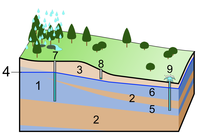
Photo from wikipedia
Subsurface barriers have been used as one of the engineering measures to prevent saltwater intrusion in the coastal aquifers in China. However, the effectiveness of those barriers has not been… Click to show full abstract
Subsurface barriers have been used as one of the engineering measures to prevent saltwater intrusion in the coastal aquifers in China. However, the effectiveness of those barriers has not been studied thoroughly. In this research, comparative studies using sandbox test as a physical model and the FEFLOW-based groundwater numerical model were conducted for better understanding of the dynamic processes of saltwater intrusion with and without subsurface barriers. Both laboratory tests and numerical simulation without subsurface barriers showed that the saltwater front intruded to 18, 55 and 63 in the aquifer in 10, 20 and 40 min, respectively. The impact of the different permeability of the subsurface barriers to the migration distance and diffusion of saltwater front was also tested in the laboratory and simulated by using the two-dimensional numerical model. Results showed the saltwater front could still pass through the subsurface barrier and continued moving forward when the permeability K of the subsurface barriers was 9.9 × 10−7 m/s. When the K of the subsurface barriers was 1.3 × 10−7 m/s, the salt–front passed through the subsurface barrier in 40 min, and the migration rate of the salt–fresh water interface did not change in 70 min. When the K was 3.7 × 10−8 m/s, the saltwater front could not go through the subsurface barriers. These research results indicated that the subsurface barriers with low permeability (K = 3.7 × 10−8 m/s) could prevent the saltwater intrusion effectively. The results of this case study provide important practical significance for the prevention of saltwater intrusion in coastal areas.
Journal Title: Natural Hazards
Year Published: 2018
Link to full text (if available)
Share on Social Media: Sign Up to like & get
recommendations!